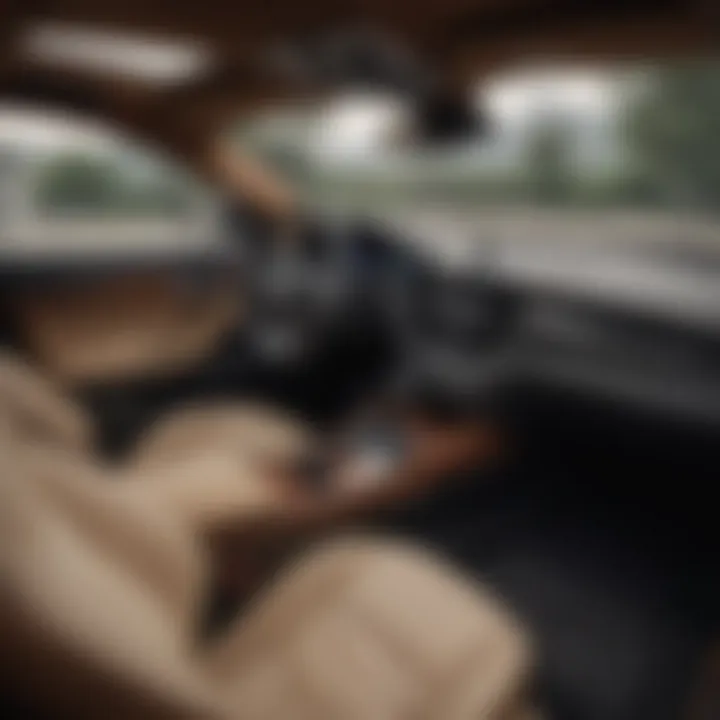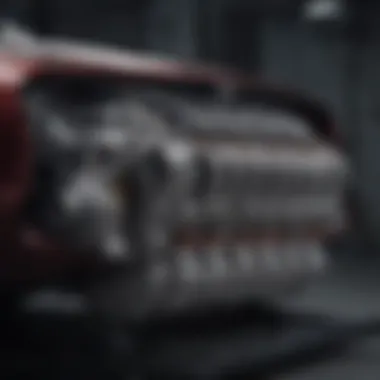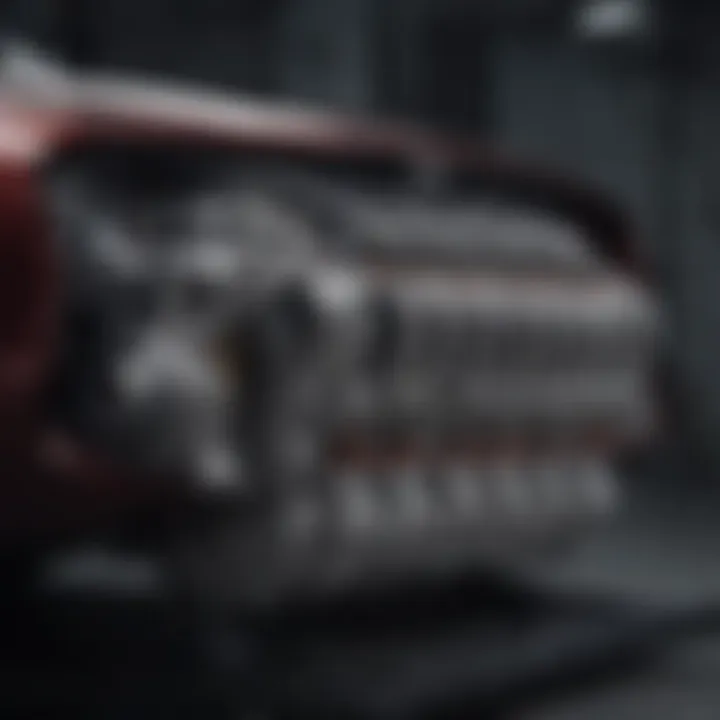The 1967 Maserati Ghibli: Luxury Meets Performance


Intro
The Maserati Ghibli of 1967 represents an important milestone in the world of luxury sports cars. While many car enthusiasts know it for its sleek design and powerful engine, its story goes far beyond just aesthetics and raw power. Born in an era brimming with automotive innovation, the Ghibli captured the spirit of the times, merging cutting-edge engineering with Italian flair. This piece aims to dissect the elements that contribute to its legacy, from its historical context to the intricate details of its craftsmanship.
Product Quality Evaluations
Methodology for Evaluating Quality
When assessing the quality of the Maserati Ghibli, it’s essential to adopt a multifaceted approach. Factors like craftsmanship, materials used, performance metrics, and customer feedback all play a significant role in understanding what sets this vehicle apart. Each aspect contributes to a full picture of quality, which helps potential buyers and enthusiasts navigate the complexities of this automotive masterpiece.
- Craftsmanship: The meticulous attention to detail by Maserati in the Ghibli's interior and exterior designs is worth noting. Each stitch in the leather seats and every polished chrome accent reflect the brand's commitment to excellence.
- Materials: High-grade materials, often sourced from the finest providers, guarantee durability and opulence. This not only enhances the driving experience but also contributes to the car's resale value.
- Performance Metrics: Evaluating performance involves looking at acceleration, handling, and braking. The Ghibli is renowned for its robust engine, which ensures a thrilling driving experience.
- Customer Feedback: Consumer reviews and testimonials provide the most grassroots perspective on the Ghibli's real-world quality. Many owners commend its blend of speed and elegance, further underscoring Maserati's mission to innovate.
Comparison of Different Models
To provide a context for the 1967 Ghibli's standing, it's useful to compare it with other contemporaneous models.
- Porsche 911 (1964): The 911 is recognized for its engineering robustness and handling capabilities. However, compared to the Ghibli, it leans more towards functionality than luxury.
- Jaguar E-Type (1961): The E-Type embodies British craftsmanship but often lacks the Italian design flair found in the Ghibli. Its powerful performance is impressive, yet its interior experience falls short of the Maserati's luxurious touch.
In looking at these comparisons, it becomes clear that while the Ghibli rivals its peers in performance, its blend of luxury and style is what truly sets it apart.
Expert Reviews and Recommendations
Comparisons of Similar Models
Experts emphasize that choosing between luxury sports cars in the 1960s was no walk in the park. Each model offered a unique set of features that appealed to different types of drivers:
- Maserati Ghibli: A stunning design coupled with muscle performance, especially in its 4.7-liter V8 variant.
- Ferrari 275 GTB (1964): Focused more on racing dynamics, the 275 offers a raw driving experience that some purists cherish but may lack in everyday usability.
- Lamborghini Miura (1966): Recognized for its revolutionary design and performance, the Miura is perhaps the closest competitor to the Ghibli in the luxury segment but at a higher price point.
Tips for Buyers
If you’re considering adding a 1967 Maserati Ghibli to your collection, take note of these recommendations:
- Documentation: Ensure that you have all service records; this will help you understand the vehicle's history and maintenance needs.
- Condition: Look for cars that have been well-maintained and documented through the years. Rust, paint flaking, and mechanical wear can significantly lower value.
- Originality: Aim for models with original parts. Restorations can impact the intrinsic value; authenticity often enhances desirability.
Investing in a classic car like the Maserati Ghibli isn’t just about performance; it’s about owning a piece of automotive art that captures a magical era.
The allure of the 1967 Ghibli endures in today’s automotive landscape, blending luxury with performance in a way few can match. As we dive deeper into its historical context and design intricacies, one can fully appreciate the impact it has had on both enthusiasts and the automotive industry at large.
Prologue to the Maserati Ghibli
The Maserati Ghibli of 1967 holds a revered position in automotive history. It represents more than just a collection of metal and wheels; it is a symbol of luxury and high performance that reflects the aspirations of car enthusiasts from its era. Understanding the Ghibli requires diving into its historical context, as well as the evolution of Maserati itself during that period.
The allure of the Ghibli lies in its seamless blend of glamorous design and impressive power. It was a car that appealed to the discerning driver seeking both speed and sophistication. In this section, we will explore the historical influences that shaped its creation, as well as how Maserati's design ethos evolved to deliver a vehicle that truly embodies luxury and performance.
Historical Context
To appreciate the Maserati Ghibli, one must consider the post-war automotive landscape. The 1960s marked a time of rapid advancement in car technology, with manufacturers racing to create powerful yet elegant vehicles. Italy, a country renowned for its craftsmanship, was also the birthplace of numerous brands that defined luxury. Maserati was among them, navigating through challenges that many manufacturers faced after World War II, including economic hardship and stiff competition.
As the decade progressed, sports cars were not merely means of transport; they became extensions of personal identity and status. The advent of the Maserati Ghibli in 1967 coincided with a peak interest in exotic cars among affluent buyers, making the timing of its launch particularly serendipitous. The Ghibli's debut was more than a new model; it represented a concerted effort by Maserati to reclaim its prominence in the luxury sports car market, which was increasingly dominated by competitors.
Maserati's Evolution
Maserati’s journey leading up to the Ghibli is notable for its commitment to performance and style. Originally founded in Bologna in 1914, Maserati crafted race cars and spurred innovations that cemented its reputation in motorsport. Fast forward to the 1960s, and the company was at a crossroads.
The design team, led by Giorgio Giugiaro, aimed to create a vehicle that combined the power of a racing machine with the elegance of Italian automotive design. The result was a coupé that caught the eye, with its voluptuous curves and aggressive stance making a bold statement on the road.
By the time it hit the market, the Maserati Ghibli was armed with a distinctive style that set it apart, embodying Maserati's transition from race-focused automobiles to luxurious sports cars. This evolution was instrumental in shaping not only Maserati's identity but also influencing the broader luxury car segment during the 1960s.


"The Maserati Ghibli is not just a car; it's an emotional experience that connects the driver to the road, a quintessential symbol of Italian craftsmanship and performance." - Anonymous Automotive Enthusiast
In summary, the introduction of the Maserati Ghibli in 1967 is steeped in a rich historical context that reflects broader automotive trends of the time as well as Maserati’s own evolution. Through the knowledge of these elements, one can better understand why the Ghibli remains a sought-after classic, treasured by collectors and automotive aficionados alike.
The Design Philosophy of the Ghibli
The design philosophy of the 1967 Maserati Ghibli is a crucial aspect that defines its identity and sets it apart from its contemporaries. This model not only exemplifies luxury and high-performance engineering but also embodies a meticulous focus on aesthetics combined with functionality. The Ghibli’s design showcases how Maserati blended form and function, leading to a car that is not just a vehicle but also a piece of art in motion.
Exterior Styling
The exterior of the Ghibli is an exquisite blend of sleek lines and aggressive stance, capturing attention at every turn. The car features a long hood that gracefully stretches into a short rear deck, establishing a classic coupe silhouette. Noteworthy are the large, distinctive front grille and the quad headlights, which provide not just illumination but also a charismatic face that commands respect. The fluidity in the bodywork reflects the aerodynamic considerations that were at the forefront of Maserati's design intentions, reducing drag while enhancing performance.
- Curvaceous Profile: The car's profile is notable for its subtle curves, which add elegance without sacrificing the muscular look essential for a grand tourer.
- Wide Stance: The Ghibli’s wide track enhances its stability, giving drivers confidence on bends, an essential trait for sports cars.
In essence, every inch of the Ghibli's exterior has purpose, from the sporty bumpers to the gracefully integrated side vents. It’s a car that not just pleases the eye, but also performs exceedingly well on road and track.
Interior Features
Inside, Maserati did not hold back. The Ghibli's cabin invites its occupants into a world of luxury and comfort, ensuring that every drive is enjoyable. Quality leather envelops the seats, providing the kind of plush experience expected from a luxury brand. The dashboard is meticulously designed, featuring an array of dials that are both functional and stylish.
- Driver-Centric Layout: The cockpit is designed with the driver in mind, ensuring that controls are within easy reach without compromising aesthetic appeal.
- Customizable Comfort: Buyers often had options to customize aspects such as seating materials, adding to the sense of opulence and personal touch.
Seating in the Ghibli comfortably accommodates four adults, making it not just a sports car, but a practical choice for those not wanting to sacrifice comfort for speed. The integration of technology at the time ensured that radio and heating controls were intuitive, even if not as advanced as today’s standards.
Color and Material Choices
The palette of colors offered with the Ghibli sought to mirror its dynamic identity. Maserati's choices for paint and upholstery were deliberate and significantly influenced the market's perception of luxury. The metallic hues, often seen glimmering under the sun, gave the Ghibli an irresistible charm.
- Classic Color Options: Common choices included striking reds and upscale shades of blue that resonated with the rich heritage of Italian sports cars.
- Premium Materials: Beyond leather, finer details included wood paneling and metal accents that added to the richness of the interior experience. Each material used was carefully selected to ensure it complemented both the aesthetic design and the luxurious feel.
"The Maserati Ghibli represents a time when style and performance were crafted in conjunction, creating a sports car that not only performed but defined a lifestyle."
As a result, the 1967 Ghibli stands as a testament to Maserati’s commitment to creating vehicles that encompass more than just transportation. Its design philosophy is crucial to understanding why the Ghibli has not only endured through the years but remains an object of desire among automotive enthusiasts.
Performance Specifications
Performance specifications are the heartbeat of the Maserati Ghibli 1967. They not only define the car's capabilities but also paint a vivid picture of the experience that comes with owning such a magnificent vehicle. For automotive enthusiasts and potential buyers alike, understanding these details goes beyond mere numbers; it's about appreciating the harmony of engineering and craftsmanship that Maserati poured into the Ghibli.
Engine and Powertrain
At the center of the Ghibli's performance lies its engine and powertrain. The 1967 model rolled out of the Maserati factory with a 4.7-liter V8 engine under its sleek hood, delivering an exhilarating 330 horsepower. This engine wasn't just powerful; it was a symphony of engineering perfection. It allowed the Ghibli to accelerate from 0 to 60 mph in an astonishing 5.4 seconds—a remarkable feat for its time.
Owning a Ghibli means experiencing that raw power with everyone taking notice as the engine roars to life. The sound is more than just noise; it’s the visceral excitement that marks the difference between a luxury car and a genre-defining performance vehicle.
Transmission Options
When we talk about the Ghibli's performance, we can't overlook the transmission options. Maserati offered a choice between a five-speed manual and a three-speed automatic transmission. The manual transmission caters to the purists who enjoy becoming one with their vehicle, allowing them to engage with every gear change. That kind of control enhances the connection between driver and car, turning every drive into a spirited adventure.
For those who prefer a more leisurely approach, the automatic transmission provides smooth shifts, ensuring a relaxed driving experience without sacrificing performance. This duality makes the Ghibli versatile; whether you’re navigating city streets or cruising down the open highway, there's a transmission option to fit your mood.
Handling and Driving Experience
Driving the Maserati Ghibli is an experience that transcends the ordinary. The car's handling is remarkably agile, thanks to its independent suspension and well-tuned chassis. The designers ensured that the weight distribution remained optimal, allowing it to take curves with a grace that belies its size. It's a ballet of power, precision, and poise.
The feedback from the steering wheel is direct and communicative, enabling drivers to feel the road and adjust their maneuvers accordingly. It's important to note how the car feels alive during each corner or straightaway. The project aims not just to move through space but rather to dance within it.
For those who value a blend of sporting spirit and day-to-day drivability, the Ghibli 1967 represents a pinnacle of automotive engineering.
The overall driving experience, from the engine response to the handling, establishes the Ghibli as not just another luxury sports car but a timeless piece of art that commands respect.


In summary, the performance specifications of the 1967 Maserati Ghibli serve as an affirmation of Maserati’s dedication to creating vehicles that resonate with performance enthusiasts. It isn’t merely about speed; it’s about a well-rounded experience rich in tradition, innovation, and unparalleled luxury.
Market Reception and Sales Figures
Understanding the market reception and sales figures of the 1967 Maserati Ghibli is crucial to appreciate its significance within the automotive landscape of its time. This section takes a detailed look into how the Ghibli was initially received, the public's reaction to this luxury sports car, and how its sales trajectory has shifted over the years. This not only highlights the car's appeal but also sheds light on Maserati's success and challenges in a fiercely competitive market.
Initial Release and Public Reaction
When the Maserati Ghibli hit the market in 1967, it was more than just a new car; it represented a bold statement in design and performance. Sporting a sleek body designed by Giorgetto Giugiaro, the Ghibli turned heads with its aggressive stance and flowing lines. The initial public reaction was overwhelmingly positive. Critics and automotive journalists praised the Ghibli’s blend of elegance and speed.
A review in a contemporary car magazine noted:
"The Ghibli comes across as a sculptural masterpiece, embodying the essence of Italian motoring, where beauty meets brawn."
Many enthusiasts were captivated not only by the car’s looks but also by its powerful engine, which allowed for impressive performance on both roads and tracks. Yet, it was not all sunshine and rainbows. Some pointed critiques surfaced regarding its price tag, which positioned it as a luxury item rather than just another sports car. Still, this exclusivity played a role in cementing the Ghibli’s status as a desirably elite vehicle.
Sales Performance Over the Years
After the initial buzz, the sales figures for the Maserati Ghibli provide a fascinating narrative. In its first year, approximately 1,200 units were sold, and while this number isn't exceptionally high by today’s standards, it was impressive for Maserati at that time. The Ghibli carved a niche for itself, appealing to affluent customers who sought performance without sacrificing comfort.
As time marched on through the late 1960s and into the 1970s, interest in the Ghibli fluctuated due to several factors, including economic shifts and evolving consumer preferences. Here’s a snapshot of how its sales evolved:
- 1967-1969: The Ghibli witnessed peak sales as it garnered praise and attention.
- 1970-1975: Sales wavered as the oil crisis influenced car buying habits. Even among its loyal fans, some hesitated to purchase a high-performance vehicle in uncertain economic times.
- Post-1975: The Maserati brand faced challenges, yet the Ghibli retained a loyal following.
Looking back, the Maserati Ghibli has weathered the ups and downs of market dynamics, resonating particularly well with collectors and enthusiasts. It is often acknowledged not just for its performance but also for its cultural significance in the automotive world, marking an era where luxury and speed began to intertwine in the minds of consumers.
As automotive history would show, the legacy of the Ghibli continued to evolve beyond mere figures, becoming a symbol of Italian excellence and craftsmanship in the industry.
Legacy and Cultural Impact
The Maserati Ghibli, a standout among luxury cars in the 1960s, left an indelible mark not only in terms of engineering but also in social and cultural spheres. Understanding its legacy sheds light on how the Ghibli contributed to shaping the automotive landscape. The vehicle is often seen as a bridge between raw power and exquisite luxury, which has been emulated but seldom matched. It’s a canvas of Italian artistry, where performance and elegance coalesce, capturing the imagination of both car aficionados and casual fans alike.
Maserati Ghibli in Popular Media
The Ghibli has graced numerous films and TV shows, solidifying its position as a symbol of sophistication and speed. Largely recognized as a status symbol, it has captured thrilling moments in cinema. One notable instance can be seen in the classic film "The Italian Job," where the car's sleek exterior matches the film’s glamorous aesthetic.
- Influence in Film and Television
- Featured in various car chases and glamorous settings, showcasing its power and luxury.
- Appeared in documentaries discussing its engineering and aesthetics, further cementing its place in automotive history.
In magazines and advertisements, the Maserati Ghibli has often been portrayed not just as a vehicle but as a lifestyle choice, representing freedom and innovation. Ads from the late '60s highlighted its performance while seducing buyers with its chic design, leaving a lasting impression.
"Driving a Ghibli is akin to wearing a tailored suit; it doesn't just fit, it defines who you are."
German Car Enthusiast, 1968
Influence on Contemporary Sports Cars
The Maserati Ghibli has set a precedent that resonates in today’s automotive sphere. Modern manufacturers continuously draw inspiration from its ability to combine raw power with an upscale presence. Elements of its design can be seen in various sports cars, which have been crafted in a nod to Ghibli's bold strokes and contours.
- Key Influence Areas
- Aerodynamics: The Ghibli’s curves have influenced the aerodynamic designs of brands like Ferrari and Lamborghini, emphasizing both aesthetics and speed.
- Engineering Techniques: Maserati set benchmarks for handling and balance, which are crucial aspects for any contemporary sports car.
- Luxury Integration: Today's vehicles often strive for the luxurious comfort that the Ghibli exemplified, mixing high-performance with plush interiors.
These influences highlight the Ghibli's role as a trailblazer in the sports car domain. Its ethos of balance between luxury and performance continues to inspire and challenge the standards for automotive excellence.
Customer Satisfaction Ratings
Customer satisfaction ratings serve a crucial role in understanding the true impact and reception of the 1967 Maserati Ghibli. In a market awash with luxury options, it’s often the experiences of actual owners that shed light on how a vehicle like the Ghibli performs beyond the glossy brochures and advertisements. These ratings encompass various facets, from performance reliability to aesthetic satisfaction, creating a holistic view that both potential buyers and enthusiasts can rely on. Considerations might range from the car's long-term reliability to the quality of service provided by Maserati dealerships.
High customer satisfaction ratings can lead to enhanced brand loyalty, encouraging former owners to stay within the Maserati family when purchasing their next vehicle. A vehicle's review also helps in gauging features that resonate with the luxury market, helping manufacturers to understand what truly matters to their customers.


Owner Testimonials and Experiences
Owner testimonials provide invaluable insight into the Maserati Ghibli's everyday performance and luxury experience. These firsthand accounts paint a vivid picture of life with the Ghibli, rather than merely highlighting its technical specs. Many owners rave about the car’s striking appearance, describing it as an eye-catching marvel that makes heads turn, whether cruising through city streets or parked at a prestigious gala.
In particular, the feedback often emphasizes the balance between power and comfort, with numerous owners noting how the Ghibli effortlessly combines sportiness with an elegantly luxurious ride. A common sentiment is that driving the Ghibli isn’t just transportation; it’s an experience. An owner from Italy shared, "Every drive feels like an occasion. The engine roars, and the interiors wrap you in comfort — it’s like being cradled in a work of art."
However, not all testimonials are glowing. Some owners report issues related to maintenance costs, saying that keeping the Ghibli in tip-top shape requires a significant financial commitment. Understanding these mixed sentiments is essential for potential buyers, providing them with a grounded view of what ownership entails.
Expert Reviews and Critiques
Expert reviews and critiques of the Maserati Ghibli have historically offered a blend of admiration and critical analysis. Many automotive reviewers laud the Ghibli's styling and performance, branding it a 'driving enthusiast's dream.' Critics highlight how the vehicle blends Italian design with robust engineering, making it stand out from the competition. One review stated, "The Ghibli embodies all that makes Maserati seduce car lovers; it is powerful, sleek, and aggressive in the right ways."
Yet, expert reviews also shine a light on some shortcomings. Areas such as interior practicality and certain technological aspects receive critique for not matching the luxury expectations set by its price range. Reviewers have pointed out the somewhat cramped back seat and limited cargo space, which can hinder its usability as a daily driver. This critique is particularly relevant for buyers who seek a balance between sporty performance and practicality.
In summation, the opinions of experts complement owner experiences, delivering a comprehensive perspective on the Maserati Ghibli. Combining both narrative forms helps potential buyers to make informed decisions, painting a fuller picture of what awaits them behind the wheel of this iconic luxury car.
Comparisons with Competitors
Comparing the Maserati Ghibli of 1967 with its competitors serves not just to illustrate its defining features but also to contextualize its place within the luxury performance market of the era. By understanding where it stood vis-à-vis other iconic automotive brands, we can glean insights into its appeal, strengths, and, perhaps, its shortcomings. This section will dissect how the Ghibli stacked up against formidable rivals, offering a nuanced look at what made it distinct.
Comparison with Other Luxury Brands
The late 1960s was a golden era for luxury sports cars, with Italian and British manufacturers vying for the spotlight. When considering the Ghibli, brands like Ferrari and Jaguar immediately come to mind. Ferrari’s 275 GTB, with its aggressive styling and potent V12 engine, definitely posed a challenge. However, the Ghibli struck a different chord. Its sleek, curvy design paired with a comfortable and classy interior attracted buyers who sought not only performance but also elegance.
Similarly, the Jaguar E-Type, long celebrated for its combination of beauty and speed, was a strong contender. While the E-Type had a more raw, spirited driving experience, the Ghibli offered a smooth ride that did not compromise on performance. Here are a few direct comparisons:
- Performance:
- Style:
- Ferrari 275 GTB: Known for its top-tier speed and racing heritage.
- Jaguar E-Type: Emphasized handling and agility.
- Maserati Ghibli: Balanced power with a luxury drive, suited for both the racetrack and leisurely cruises.
- Ferrari: Aggressive and sporty look appealing to racers.
- Jaguar: Long hood with a distinctive silhouette that screams elegance.
- Maserati: Luxurious curves and refined lines, merging performance with comfort.
In sum, while competitors may have outperformed the Ghibli in raw power or agility, Maserati carved out a niche that prioritized luxury without sacrificing speed.
Positioning in the Market
Positioning the Ghibli in the market during its launch is intriguing. Maserati aimed squarely at affluent buyers who desired more than just a sports car. The Ghibli was an invitation to experience a blend of comfort and speed, all thanks to its thoughtful design and engineering.
As potential buyers navigated their choices, the Maserati stood out not only for its aesthetics but also for the promise of prestige. With a price point that hovered around the same as Jaguar and Ferrari models, Maserati marketed the Ghibli as an all-around performer – a splendid car for daily use, yet ready to thrill on the weekend.
The allure of owning a Maserati has always been its exclusivity. Below are some points illustrating its market stance:
- Luxury Appeal: It attracted buyers looking for exclusivity and high craftsmanship rather than racing pedigree alone.
- Cultural Significance: Being a Maserati didn’t just mean owning a car; it meant becoming part of a lifestyle that appreciated art, beauty, and performance. For wealthy aficionados, the Ghibli represented a ticket into this elite club.
In the grand scheme, the Maserati Ghibli of 1967 was more than just a contender in the luxury sports car arena; it was a symbol of aspiration and sophistication, appealing to those who understood that true performance could coexist beautifully with luxury and style.
The End
The closure of our exploration into the Maserati Ghibli of 1967 serves to highlight several crucial points pertinent to its legacy in the automotive realm. At its core, this iconic vehicle not only encapsulates superior engineering but also reverberates with historical significance. The Ghibli stands as a testament to Maserati's commitment to merging opulence with performance. This combination speaks volumes about the brand's identity and its place in the pantheon of luxury sports cars.
Summation of Key Points
Throughout our discussion, we have unearthed various layers that define the Maserati Ghibli:
- Historical Context: Launched in the pivotal late 1960s, the Ghibli entered a market ripe for innovation.
- Design Excellence: Its striking aesthetics are defined by clean lines and a daring interior, blending style with functionality.
- Performance: With a robust engine and precision handling, it offers not just speed but an exhilarating driving experience.
- Cultural Impact: The Ghibli has infiltrated pop culture, appearing in films and arts, further enriching its allure.
- Customer Satisfaction: Owner testimonials reveal a deep-rooted connection between enthusiasts and their vehicles, cementing the Ghibli as a beloved choice amongst drivers.
"The Maserati Ghibli is not just a car; it's an experience, a glimpse into a past where luxury and raw power coexisted."
Future Trajectory of the Ghibli Line
Looking forward, the future of the Ghibli line seems promising, yet it navigates a path crowded with electrification and sustainability trends. Maserati must adapt to a world where environmental consciousness shapes consumer preferences. The challenge lies in maintaining the essence of the Ghibli while embracing new, greener technologies. There's potential for hybrid or electric variants to emerge, which could revolutionize the brand’s offerings without compromising the driving excitement that has always defined it.
Moreover, consumer desires are shifting; buyers are increasingly drawn to personalization and unique experiences, as opposed to mere horsepower. Maserati could capitalize on this by introducing bespoke options tailored to individual tastes.
In summary, while the Ghibli of 1967 left an indelible mark on automotive history, its evolution hinges on balancing tradition with innovation. The journey ahead will require a deft hand to cultivate its legacy in harmony with the demands of the modern driver.



